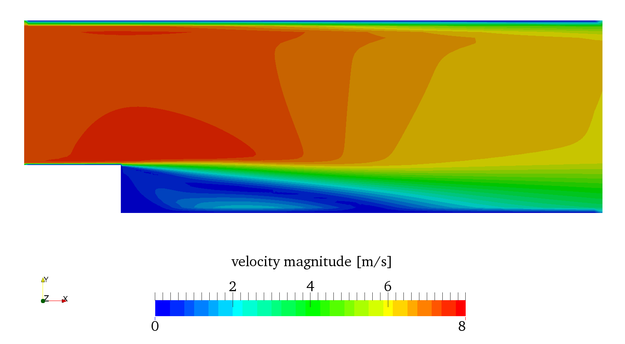Difference between revisions of "Stationary turbulence modeling (RAS) by Jozsef Nagy"
Jump to navigation
Jump to search
Jozsef Nagy (talk | contribs) (Created page with "* '''author''': Jozsef Nagy * '''affiliation''': Institute of Polymer Injection Molding and Process Automation, Johannes Kepler University Linz, Austria * '''contact''': jozse...") |
Jozsef Nagy (talk | contribs) |
||
| (24 intermediate revisions by 2 users not shown) | |||
| Line 1: | Line 1: | ||
| − | * ''' | + | [[category:turbulence]] |
| − | * '''affiliation''': | + | [[category:RAS]] |
| − | * '''contact''': | + | * '''contributor''': Jozsef Nagy |
| − | * '''OpenFOAM version''': | + | * '''affiliation''': eulerian-solutions e.U., Linz, Austria |
| − | * '''Published under''': CC BY-NC-SA license ([https:// creativecommons.org/licenses creative commons licenses]) | + | * '''contact''': <mail address='jnmlujnmlu@gmail.com' description='author'>click here for email address</mail> |
| + | * '''OpenFOAM version''': v2006 | ||
| + | * '''Published under''': CC BY-NC-SA license ([https://creativecommons.org/licenses creative commons licenses]) | ||
Go back to [https://wiki.openfoam.com/index.php?title=Day_7 Day 7]. | Go back to [https://wiki.openfoam.com/index.php?title=Day_7 Day 7]. | ||
| − | =[https:// www.youtube.com/watch?v=IPExwi2Ar-g Stationary turbulence | + | =[https://www.youtube.com/watch?v=IPExwi2Ar-g Stationary turbulence modelling (RAS)]= |
| − | + | [[File:vel_jnagy.png|625px|right|steady-state velocity distribution]] | |
| − | + | Most of the real life problems you would like to tackle include some sort of turbulence. These [https://www.youtube.com/watch?v=IPExwi2Ar-g videos] | |
| − | |||
| − | |||
| − | + | * [https://www.youtube.com/watch?v=IPExwi2Ar-g part 1] | |
| + | * [https://www.youtube.com/watch?v=CMchl-1d-zI part 2] | ||
| + | * [https://www.youtube.com/watch?v=-46pgYQYER8 part 3] | ||
| − | * steady-state turbulence | + | will give you a detailed explanation on steady-state turbulence modelling in OpenFOAM. It is important to understand the difference between models and which one to choose for a given problem. It is also important to know, how to select a specific model and what you have to change in order to run a successful simulation. You will learn about |
| + | |||
| + | * steady-state turbulence modelling | ||
* Reynolds-Averaged Navier-Stokes equations | * Reynolds-Averaged Navier-Stokes equations | ||
* RAS models | * RAS models | ||
* case setup | * case setup | ||
* boundary and initial conditions | * boundary and initial conditions | ||
| − | * | + | * post processing |
| + | |||
| + | You can download the blockMeshDict [https://github.com/jnmlujnmlu/OpenFOAMTeaching/tree/master/JozsefNagy here]. (left click on it, then right click on Raw, then save as) | ||
| + | |||
| + | For older versions of OpenFOAM the blockMeshDict file is located in constant/polyMesh, for newer versions the file is located in system. | ||
| + | |||
| + | In newer versions of OpenFOAM the RASProperties dictionary is replaced by turbulenceProperties, however the important entries remain the same. | ||
| + | |||
| + | In newer versions of OpenFOAM the commands ''yPlus'', ''yPlusLES'' and/or ''yPlusRAS'' are not used. Instead AFTER your simulation run the command ''simpleFoam -postProcess -func yPlus'' | ||
Revision as of 04:56, 28 July 2020
- contributor: Jozsef Nagy
- affiliation: eulerian-solutions e.U., Linz, Austria
- contact: click here for email address
- OpenFOAM version: v2006
- Published under: CC BY-NC-SA license (creative commons licenses)
Go back to Day 7.
Stationary turbulence modelling (RAS)
Most of the real life problems you would like to tackle include some sort of turbulence. These videos
will give you a detailed explanation on steady-state turbulence modelling in OpenFOAM. It is important to understand the difference between models and which one to choose for a given problem. It is also important to know, how to select a specific model and what you have to change in order to run a successful simulation. You will learn about
- steady-state turbulence modelling
- Reynolds-Averaged Navier-Stokes equations
- RAS models
- case setup
- boundary and initial conditions
- post processing
You can download the blockMeshDict here. (left click on it, then right click on Raw, then save as)
For older versions of OpenFOAM the blockMeshDict file is located in constant/polyMesh, for newer versions the file is located in system.
In newer versions of OpenFOAM the RASProperties dictionary is replaced by turbulenceProperties, however the important entries remain the same.
In newer versions of OpenFOAM the commands yPlus, yPlusLES and/or yPlusRAS are not used. Instead AFTER your simulation run the command simpleFoam -postProcess -func yPlus
